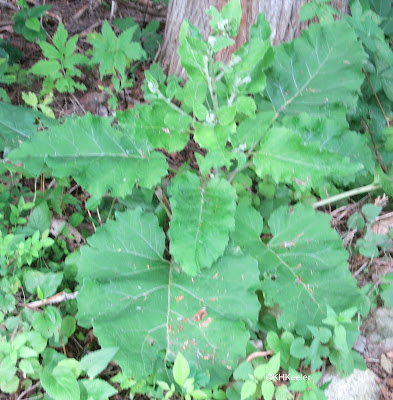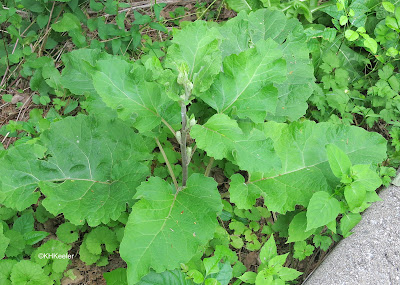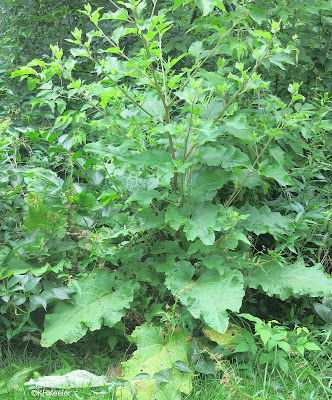Burdocks are plants you recognize for their seed pods or leaves. Oh, they have pretty enough pink-purple flowers, much like thistles flowers, but the seed pods have spines with hooks that stick tightly to clothes or fur, and the leaves are very large.
 |
| burdock, Arctium |
Burdock, the genus Arctium, in the sunflower family, Asteraceae, has ten species, all of them Eurasian. At least four species have been introduced to North America and are pretty widespread. These are the common burdock, Arctium minus, which is found in all of the lower 48 states (truly, it's common!), greater burdock, Arctium lappa, found in all but 17 states, woolly burdock, Arctium tomentosum, in 17 states, and woodland burdock, A. vulgare, in eight states.
 |
| burdock leaves |
Burdocks are coarse herbs with big leaves--to more than 2 1/2 feet long! They are biennial, growing as a nonflowering cluster of leaves for a year, storing energy, then bolting into flower the second year, and, after putting all their stored energy into seeds, dying. The flowering plant can reach 9 feet all. A single plant of common burdock was reported to have produced over 300,000 seeds, though of course most have many fewer.
 |
| burdock, Arctium |
The name burdock is "bur" and "dock": they look a lot like dock (Rumex) plants, but have burs. Burdocks are memorable and widely distributed, so they have many common names, for example bardane (one of its French names), beggar's button, stick buttons, clotbur (clot or clote was an English common name for similar plants), cockleburs (also the name for plants in the genus Xanthium), cuckoo-buttons, hardock (origin unknown, from Shakespeare's time), and fox's clote (another old common name). Culpeper writing in 1632 gives other common names that seem to be obsolete.
The scientific name for the genus, Arctium, is from its Greek name, arction, which is based on the Greek for bear, arctos, reportedly because the leaves around the flower head (involucre) are so rough-textured. The species epithet minus means small, lappa is an old word for a bur, tomentosa means hairy and vulgare, common.
 |
| burdock in flower |
The seed pods (burs) ripen and dry out with a hooked spine attached to each seed. The hooks easily attach to animals or people who brush by. The hook is tough and can be painful if you have to detach it from skin. This very effective structure has let burdocks hitchhike all over the world; from Eurasian roots, they are now worldwide. Of course, they are highly disliked by everyone who has tried to pull them out of their socks, let alone remove them from the hair of their dogs.
The tenacity and structure of burdock's burs is given credit for inspiring Velcro. In 1941, Swiss electrical engineer and inventor George de Mestral hiked with his Irish pointer in the Jura Mountains of Switzerland. After the hike, he pulled a lot of burs out of his pants and from his dog. Looking at the shape of those burs under a microscope, he was inspired to form a hook-and-loop fastener. It took him years to get the materials right and more time for people to accept this new form of fastener, but today his Velcro, named as a combination of velours (velvet in French, a cloth of loops) and crochet (French for hook), is a household word and a popular product.
Some online sites say the plant whose hooks Velcro copies is cocklebur. They may be using cocklebur as a common name for burdock (see above), but they also use a picture cocklbur seeds, Xanthium strumarium, which are (American) football-shaped, not round like burdock. Another site called the plant "mountain thistle," a plant I can't identify. I was unable to find a source I trusted as authoritative that named the plant. It may be that de Mestral didn't know or care which plant had the inspiring hooks. From some hikes you come back carrying a mix of seeds on your clothes. Burdock is the most likely candidate, however.
 |
| burdock leaves and young flowering shoot |
In 1998, J. Raloff reported in Science News (154:Oct 17, 1998 p. 244 link) that four ruby-throated hummingbirds were caught in burdock fruits in Rock Creek Park, Washington, D.C. One bird was rescued but the others were so snared by the burs, made worse by their struggles, that they died. This case is unusual but not unique; burdocks are known to have snared and killed other birds and a few bats.
Despite being very annoying and expensive to remove from wool on sheep, burdocks are not on many noxious species lists in the United States, chiefly Montana and Wyoming.
When cows graze large quantities, the bitterness gets into their milk.
So, having made it sound like a terrible pest, it is time to say: burdock root is a standard Japanese vegetable and raised commercially there. The Japanese name is gobō. Gobō is used much like we use carrots. It has a pleasant taste and is slightly crunchy. Usually the brown outer layer is scraped off, but that isn't necessary. It is commercially available in Asian groceries and rather readily foraged. The Japanese grow mainly greater burdock, Arctium lappa, but all the species are edible.
 |
| young flower stalk on burdock, Arctium |
Reading foraging works, the whole plant can be eaten but gets quite bitter. New leaves and flower stalks are more palatable than mature leaves. The stalks can be stripped of their bitter outer layer and eaten like asparagus. The inner stalk, boiled in water with a little sugar becomes a syrup, which rolled in sugar, is a sweet treat recommended by Jack Sanders (see references). If you are going to dig the roots, the part of the plant most often eaten, choose first-year plants; by the second year the roots are very woody. Since the first year plants don't have flowers, be careful getting the identification right. Below ground, burdocks usually have a long straight root, of which the tip and middle are the tastiest. This suggests choosing middle-sized plants so you don't have to dig nearly as far for the best parts. See Samuel Thayer's The Forager's Harvest for more useful advice (see references). Burdock is a mild diuretic; don't eat a lot the first time.
Burdocks have been used medicinally for millennia. The plants contain compounds that are antibacterial, antioxidant, and reduce inflammation. Burdock has a very long history of use for skin ailments from dry skin to acne to psoriasis. It is a blood purifier in Traditional Chinese Medicine, and European herbal medicine has used it for rheumatism and as a stomach tonic. However, none of the medical scources I consulted reported any studies of burdock efficacy, so all the uses have to be listed as unproven.
 |
Not surprisingly, burdock has a lot of folklore.
Children everywhere have enjoyed sticking burdock burs on people. In Essex, England, if the thrown bur stuck, the person had a boyfriend or girlfriend, if it fell off, none.
In Cornwall, England, when the colts came in covered in burdock burs, the people said they'd been ridden wildly all night by pixies, who reveled in weaving the burs into the colts' manes and tails.
Culpeper wrote that a pregnant woman could position the fetus whichever direction she liked by spreading burdock leaves or seeds. If put on her head, the child turned upward, on the mother's feet, downward or, to slow birth, spread the burdock across the womb area.
To ward off negativity, cast burdock around your home. Better still, gather burdock root under the waning moon, cut it into small pieces and string them on red thread to wear as a necklace that will protect against evil and negativity.
In Queensferry, near Edinburgh, Scotland, on the second Friday of every August, the Burryman walks through the town covered from head to toe in burdock burs, a tradition going back centuries (earliest record 1687). Today he gathers donations for the Ferry Fair, but what the tradition originally signified has been forgotten (pictures and more information: Queensferry, Wiki , Scotsmag).
In the Victorian language of flowers, burdock meant "importunity" and "touch me not".
 |
| burdock with green fruits |
Burdock is a famous and readily identified plant. And yet, for me, it was a surprise to realized the burdock root I liked so much in Japanese cooking was the big bur-covered plant I avoided when hiking.
Comments and corrections welcome.
References
Beardshaw, C. 2013. 100 Plants that Almost Changed the World. Papadakis Publisher, Winterbourne, Berkshire. England.
Culpeper, N. originally 1632. Culpeper's Compete Herbal. Foulsham Press. London. Online: link
Cunningham, S. 1984. Cunningham's Encyclopedia of Magical Herbs. Llewellyn Publications, St. Paul, Minnesota.
Greenaway, K. 1979. Originally 1884. Kate Greenaway's Language of Flowers. Avenel Press, New York. Online. link
Sanders, J. 1993. Hedgemaids and Fairy Candles. Ragged Mountain Press. Camden, Maine.
Thayer, S. 2006. The Forager's Harvest. Forager's Harvest Press. Birchwood, Wisconsin.
Vickery, R. 1995. Oxford Dictionary of Plant-Lore. Oxford University Press. London.
wow
ReplyDelete